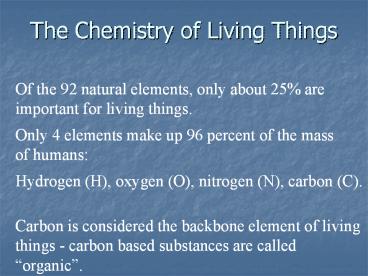The Chemistry of Living Things - PowerPoint PPT Presentation
1 / 12
Title:
The Chemistry of Living Things
Description:
The Chemistry of Living Things Of the 92 natural elements, only about 25% are important for living things. Only 4 elements make up 96 percent of the mass – PowerPoint PPT presentation
Number of Views:75
Avg rating:3.0/5.0
Title: The Chemistry of Living Things
1
The Chemistry of Living Things
Of the 92 natural elements, only about 25
are important for living things.
Only 4 elements make up 96 percent of the mass of
humans
Hydrogen (H), oxygen (O), nitrogen (N), carbon
(C).
Carbon is considered the backbone element of
living things - carbon based substances are
called organic.
2
Structure of Elements(atoms)
The smallest whole unit of an element is the
atom. Atoms consist of Subatomic Particles
1. Protons - a positive charge 1 2. Neutrons -
no charge, neutral 3. Electrons - a negative
charge -1
Protons and neutrons are found in the nucleus.
Electrons move around the nucleus in electron
clouds.
Usually, the of electrons of protons
3
Chemical bonds between atoms
Normally, atoms bond (combine)with each other to
form compounds ExamplesCO2, H2O, C6H12O6
When atoms combine and share electrons, a
covalent bond is formed between them. This group
of atoms is then called a molecule. Ex. O2,
H20, CH4 ( 2 nonmetals) When atoms combine by
donating electrons forming oppositely charged
particles the atoms are held together by an ionic
bond. Ex. NaCl, Fe2O3 ( metal nonmetal)
4
Water Our most important molecule
Water is important in living things because
1. It dissolves other substances very well
universal solvent and allows them to move and
collide with each other.
2. It transports substances from one place to
another and makes up nearly 70-95 of all
organisms.
Water is a polar covalent molecule.
Polar means that it has unequal sharing of
electrons and this gives it positive ends and
negative ends.
Note Non-polar means equal sharing electrons.
5
Characteristics of Water
Because water is polar it
Attracts strongly to other water molecules (
cohesive) this means that water resists
temperature changes and it also provides surface
tension.
It can dissolve almost any substance that has
positive and negative parts. (about 95 of all
substances)
Therefore Water is the perfect substance for
living things
6
Assignments for Unit
1. Complete vocabulary list isotope, mixture,
solution, solvent, solute, metabolism,
catabolism, anabolism, chemical equation,
reactant, product, pH, acid, base 2. Complete the
basic chemistry review
7
LIFE SUBSTANCES
8
The 4 other key molecules of life
1. Carbohydrates (sugars, saccharides, starches)
2. Lipids (includes fats, oils, and waxes).
3. Proteins
4. Nucleic acids - includes DNA and RNA
(the genetic material)
Each of these molecules contain the
elements carbon, hydrogen, and oxygen as key
parts.
9
Carbohydrates (sugars, saccharides)
Used by cells to store and release energy
Contain C,H,and O with a 2-1 ratio of H to O
Types of Carbohydrates
1. Monosaccharides - one unit sugar Ex. glucose
2. Disaccharides - two unit sugars Ex. Sucrose
3. Polysaccharides - many unit sugars
Examples Starch found in plants Glycogen -
found in animals
10
Lipids (fats)
Cells use lipids for long term energy
storage, insulation, and protective coatings.
They contain C,H and O but they have a high
proportion of C-H bonds - these bonds store a lot
of energy Ex.
The most common lipid consists of 3 fatty
acids and a glycerol molecule triglyceride
11
Proteins
Proteins are the most important functional
molecule in living things. Proteins contain C,
H,O, and N.
The building block or a protein is called an
amino acid
Proteins
1. Are building blocks for most structures in the
cell.
2. Carry out muscle contraction and provide
immunity
3. Act as enzymes to speed up chemical reactions
in our body.
12
Nucleic Acids
- A macromolecule that stores information in cells
in the form of a code. - Made up of smaller sub-units known as
nucleotides. - Nucleotides consist of the elements C, H, O, N, P
arranged in 3 groups - a base, simple sugar, and a phosphate group































